Episode 224
What you’ll learn in this episode:
- Jennifer’s unique process of layering acrylic and art images, and how she discovered her signature technique.
- Why the most important thing a young artist can do is find their voice.
- Why Jennifer rarely uses images her customers request in her jewelry.
- How Jennifer’s work ties into the history of pop and op art.
- Why Jennifer sees other art jewelers as inspiration, not competition.
About Jennifer Merchant:
Jennifer Merchant is a studio t based in Minneapolis, MN. She graduated with a BFA in Metals and Jewelry from the Savannah College of Art and Design. She is a full-time artist showcasing her work in galleries, museums and exhibitions. Her work has been published in several national magazines such as American Craft, Ornament and Delta Sky Magazine.
Merchant is best known for her innovative layered acrylic process in which images and prints are layered between solid acrylic. Her work is graphic with clean lines and modern aesthetic. Pieces confound viewers, appearing transparent from one angle of view while showcasing bold patterns and colors from another.
Photos:
“Op Art Fancy Drops”
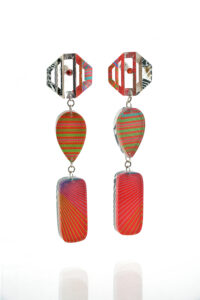
“Pop Art Fancy Triangle Drops”
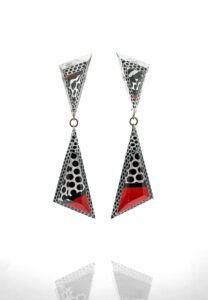
“Op Art and Gold Chain Link Necklace with Rubber Cord”
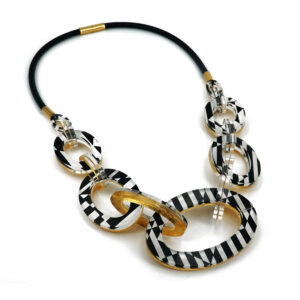
“Pop Art Circles Hinge Bracelet” profile view
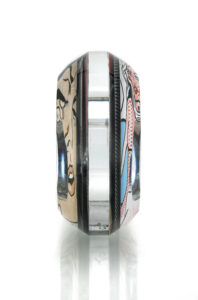
“Pop Art Circles Hinge Bracelet”
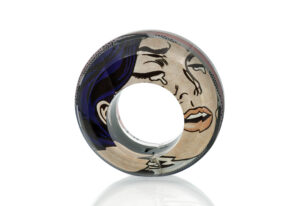
“Pop Art Dome Statement Necklace” front view
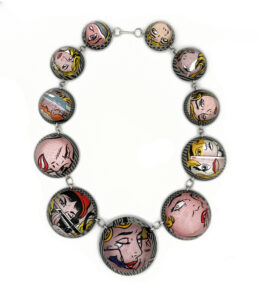
“Pop Art Dome Statement Necklace”
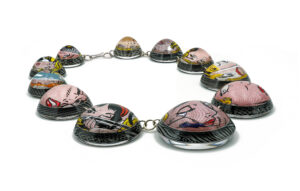
“Pop Art Double Gem Ring”
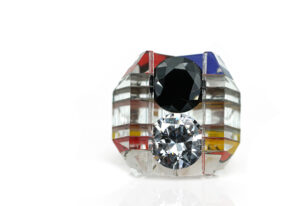
Additional resources:
Transcript:
Like the op and pop art that inspires it, Jennifer Merchant’s jewelry challenges your eye. Clear from some angles and bold and colorful from others, the jewelry is created by layering acrylic with images from art books. Jennifer joined the Jewelry Journey Podcast to talk about how she developed her technique; how she chooses the images in her jewelry; and why art jewelers need to work together to push the discipline forward. Read the episode transcript here.
Sharon: Hello, everyone. Welcome to the Jewelry Journey Podcast. This is the first part of a two-part episode. Please make sure you subscribe so you can hear part two as soon as it’s released later this week.
Today, my guest is Jennifer Merchant. Jennifer was also a guest several years ago. She thought she would be a metalsmith but segued to acrylic jewelry, which is what she has become known for: creative and innovative acrylic jewelry such as necklaces, bracelets, earrings and brooches. They have eye-catching graphics embedded in them. I was also surprised to learn that hand carving is sometimes involved.
Jennifer exhibits all over the country. She’s been an active member of SNAG, the Society of North American Goldsmiths. She is also a member of other major jewelry organizations. Jennifer is going to tell us all about why she has chosen this route and her process in general. Jennifer, welcome to the program.
Jennifer: Thank you so much for having me, Sharon.
Sharon: I’m glad to have you. Why did you start working with acrylics?
Jennifer: I actually started working with acrylic while I was still in college at the Savannah College of Art and Design studying metalsmithing and jewelry. Our professor gave us little chunks of acrylic one day, probably with the thought of using it for die forms. But I decided, “Hey, you can cut and sculpt this very similarly to working with waxes for lost wax casting.” I liked the immediacy of the acrylic, that once you carved it and sculpted it and polished it, it was a finished piece. It had a lot of really cool optical properties. So, I always kept it on the back burner as an interesting material.
Then when I graduated from college and I moved back to my hometown of Minneapolis, I didn’t have the tools and equipment to keep working with metal. So, I kind of fell into, “Hey, there was that acrylic I worked with a couple of times in school. It was very interesting. Let’s see what we can do with that,” because it was cheap, and I could cut it with simple tools. I started experimenting with it from there.
Sharon: And you make all sorts of jewelry with it. Do you know when you start out that you’ll be making a necklace or a bracelet with the pieces you have, or do they talk to you as you put them together?
Jennifer: I make pieces both ways. Sometimes I’ll design a piece very specifically and have an idea and a picture in my mind of what I’m making. But then there’s other times, especially when I’m working with the scraps that are left over from pieces that I’ve made in the past. A lot of those scraps are still very interesting, and they’ll be in weird shapes. Those will speak to me, and I’ll create something new and different with some of those. I kind of work both ways.
Sharon: I know you’re in a lot of stores and galleries. Do stores tell you what to do, or do you just say, “Here it is, do you like it”?
Jennifer: I’m more of a, “Here’s what I’ve been making. Let me know which ones you like.” I think sometimes it’s important to follow your own inspirations. People tend to be drawn to the things that I’m most excited to make.
That being said, some galleries have different clientele bases with different price points, so they’ll tell me, “Hey, these pieces were working really well.” I’ll take some feedback. But ultimately, I focus on making the things that I’m drawn to.
Sharon: Do you have a studio inside your home or do you have a place that you go?
Jennifer: For years I did have a studio outside of my home that I really loved, but a few years ago my husband and I bought a home, and I decided to move my jewelry practice into my home. So, now I work from home. But who knows, maybe in the future I’ll expand a little bit and have another space in addition outside the home. It can be kind of a challenge working at home sometimes, but I’ve done both. I like working both ways, so we’ll see what the future has for me.
Sharon: Do you have assistants who work with you?
Jennifer: I’ve had assistants in the past. I don’t anymore. I scaled my business way back during COVID and took a breather to reevaluate what I’m doing and where my motivations are. I’m only just beginning to build it back. At this point, I don’t work with anyone, but hopefully in the future I can find someone to help out with some of the production.
It’s a little challenging to find an assistant because my process is very unique. It’s not something that people know how to do, so there’s a lot of training involved. When I do work with people, it takes quite a while to get somebody that can help finish pieces to the quality standards that my galleries and clients expect.
Sharon: When you were reevaluating things, what did you decide? Did your method change during COVID?
Jennifer: I think things just slowed way down during COVID. 2020, honestly, it was going to be my year. I had a couple of really big events planned, one of which I got to do because it was in February, but the rest all moved online. There was such a lull in events and things to participate in. I had started questioning what my motivations are, because you really have to love what you’re doing in order to be an artist as a profession. We had bought a house and were settling in. I’ve just been taking the last few years to figure out life so I can bring my A-game to my business again.
Sharon: Did you stop production because you were doing it yourself during COVID?
Jennifer: I did slow way down on production. If I had a client that was interested in something, or if I had an online event or that kind of thing, that would motivate me to produce some new pieces. But there were just fewer things going on to spark that creation.
I have a harder time making things just because. I like to have an outside influence, like a show that’s coming up or events that are going to happen and people are going to see my pieces. When I don’t know when those things are going on, I have a little bit of a harder time. I think that is why during COVID, everything slowed down for me especially.
But it also gave me a lot of time to think about what I want out of my business and where I want to go. And in May, I’ll be launching my first web shop where you can actually buy my pieces directly from me.
Sharon: Wow. I know that’s a Herculean task.
Jennifer: For me personally, the web shop is an extra big step because all of my pieces, even my production work, is one of a kind because of the images I’m using within my jewelry. They’re all found images from art books and other sources. So, even if it’s the same shape, like the marquee hoop earring, no two are going to be the exact same. So, every time I list a piece online for sale, I have to photograph each and every single one of them.
It’s taken a long time to get some of those things down where I could do it quickly enough and efficiently enough to be able to post all of these pieces with the right listings. It’s a lot more work than having a design where you can put a picture of it and sell 25 of them. It’s been a daunting thing to tackle.
Sharon: Did you have to wait until you were efficient at photographing and making them so you could just churn them out?
Jennifer: My work is very difficult to photograph because it is clear and transparent from some angles, and then it’s bright and colorful from others. It’s also very reflective. So, trying to photograph it cleanly and communicate the piece in a single image is very difficult. My work tends to resonate more from multiple angles. It has taken years to figure out the best way to represent these pieces in an image or two.
Sharon: The online shop, do you think it’s your most valuable social media outlet? Is there one? What do you think that is?
Jennifer: For me, I’m not huge on social media. Instagram, I think, is the most fun. It’s very image forward, which is something I really enjoy. Definitely, as I launch my website, I will be on social media a lot more to market. I think up until now I’ve mostly worked with galleries and shops or done specific events, so I haven’t cultivated my online audience as much. I’m excited to explore that new chapter and get more into it and see what I can do from my home. That way in the future, when something happens where in-person events may not be happening as much, I can still have a connection to my audience.
I’ve been getting asked for years, “Where can I find your pieces?” Because everything is one of a kind, if it’s at a gallery in California, someone in Georgia is going to have a hard time getting their hands on it. I think it’ll be really nice having my own shop so that people can have one destination to go, as well as all of the others, to be able to have that access.
Sharon: How did you start getting galleries and stores interested in you?
Jennifer: I have been contacted by most of the places that I work with. Earlier in my career, I did a lot more events and shows and I was able to meet gallery owners. Also, early on in my career, I met some of the people that work for the American Craft Council, which is based in Minneapolis. When they saw a local Minneapolis artist at a show in Chicago and met me and thought my work was cool, they were like, “You’re in our city. Let’s invite her to some events.” They really took me under their wing and wrote about my work and got me out there. I got a lot of contacts just from people seeing the articles that they had posted.
For me, it’s been a lot of just doing what I do, and because my work is so unique and different, people that it resonates with will remember and contact me, like, “Hey, we’ve never seen anything like this. Let’s try it out at our gallery.” I’ve been very fortunate in that way, where I haven’t really had to go out on my own, cold calling and trying to get appointments and that sort of thing. I just try to make really interesting work, get it out there as much as I can, and then hope that it snowballs from there. So far, that’s been working for me.
Sharon: Wow. I think it’s great that you didn’t have to cold call and that people were interested in your stuff, which is very unusual. I don’t know anybody who does anything like that. So, you’re very lucky.
Jennifer: I’m very lucky that it worked out for me because I can be a little socially awkward with the cold calling and things like that. That was never my favorite part of the business. I am fortunate that my work speaks for itself. It’s kind of a love it or hate it thing, which can be its own challenge, but it’s definitely unique enough where when people see it, if they’re interested, they will hunt me down and ask me about it. That’s been very nice.
Sharon: If an outlet wants more than one, maybe they want five bracelets, do you tell them right away that you can make the five bracelets, but they’ll all have different graphics?
Jennifer: Yeah. I did a couple wholesale shows a while ago where it was that challenge of, “Well, here’s a design, but they’re all going to be different, and you’re not really going to know until you get them.” I think most people that are interested in my work like that one-of-a-kind nature of it. That’s part of the interest, so they trust me. If they get pieces that maybe that imagery doesn’t speak to them or their clientele, we’ll talk about it and I can swap it out, get them some prints and patterns that they like better. It’s kind of a back-and-forth process. And the longer I work with a gallery or a person, the more I get to know what works there. Then I can tailor my offerings to them for what works.
Sharon: Where do you find your images and the pictures that you put in your jewelry?
Jennifer: When I first started, I was using magazines because they were readily available, fairly inexpensive, and that’s how I started this whole process of layered acrylic. But the paper in those is not very good quality and the pictures fade. It’s also a challenge to find enough usable content.
So, then I started purchasing art books. I would become interested in a specific artist and start collecting books about their work, and those books always had a lot of really amazing images. They’re printed on really nice paper with good quality inks, and they’re much more successful layering than magazines. Now I exclusively use books. I’ve become somewhat of a rare and vintage book collector. It’s a really fun part of my job, hunting down these different books, figuring out artists that inspire me to start collecting things about their work and then finding really cool images.
If there’s a particular book that has a lot of really great images that I like, I will start looking for other copies of it. There are certain books about Roy Lichtenstein’s work. There’s one about posters that has a catalog in the back with all these smaller thumbnail images, and they’re so great for making earrings, things like that. I must’ve bought that book like 10 times. So, that’s where I get my images. It’s all purchased materials like books that I then rip up and cut up and put in between the acrylic.
Sharon: Well, you answered the question. I was going to ask you if you cut the books up or what you do. You also mentioned that magazines got you going with layered acrylic. Can you tell us about that?
Jennifer: When I was younger, I subscribed to all kinds of fashion magazines and fun things, and I would keep them after reading them. I had shelves and shelves of magazines. When I first started working with acrylic, I had this idea that acrylic has pretty cool visual properties, optical properties, and when you put images underneath it, it looks so interesting. That’s when I started going through my fashion magazines, lots of issues of Vogue. I would see cool prints on dresses and things like that, and I would rip those pages out and try to fit the prints and things that were in there within my jewelry designs. That’s how I got started with the whole thing. It was just cheap materials I already had.
Sharon: What are your sales policies? Do you accept returns? If I’m a client and you give me something and I say, “No, that’s not what I want,” do you accept returns? What do you do?
Jennifer: Yeah, I do accept returns. I think it depends. If it’s a piece that already existed and they buy it and it just didn’t work out, or it doesn’t fit quite right or it wasn’t what they were expecting, absolutely. It becomes a little more of a gray area when it’s a custom piece, when someone wants specific imagery and this and that. That tends to be a little more delicate. That being said, I want people to keep my jewelry because they love it, not because they’re trapped. So, even a custom order, if it doesn’t come out quite as they were expecting, I try to work with people to either make it right or try something new.
Some of the events that I do, it’s a museum show where they’re handling the sales and they’re getting a commission, I’m getting a commission from the sale. Even though I’m selling to the customer directly, because it goes through the museum, usually it’s an all-sales-are-final type situation, just because of the nature of the commissions and if they’ve already paid me and then the person changes their mind. It depends on the venue through which I’m selling the work.
I would say most times, yes, returns are acceptable within a certain time frame, but there are certain instances where they are final sale. But even in that situation—I had a client come a couple of years later to a show, and she had this ring. I decided, “You know what? It’s a really cool ring. Let’s swap it out.” She wanted a pendant. I like to be a little flexible. Like I said, I want people to have my jewelry because they love it, not because they’re forced to keep it.
Sharon: I’m curious; in your studio, do you have pets that keep you company?
Jennifer: I do. I’ve got a dog and a cat. My cat, Shackleton, likes to work with me. I have two workspaces in my home. Downstairs is the shop, the studio, and then upstairs I have an office where I do the bonding and the image gathering and looking through layouts. The cat, Shackleton, likes to hang out upstairs in the office and sit on all my papers and be in the way, but be very cute. Then my dog, her name’s Sophia. She tends to stay out of the studio because it’s loud and dusty. She’ll come in the office and hang out, too, sometimes. But I don’t know. She kind of does her own thing. She lets me work.
Sharon: Well, it sounds like nice company. Do you make more than one piece at a time? All the pieces and extras, let’s say, do you put them in a closet and then pull them out if somebody wants them? What do you do?
Jennifer: I definitely always have some inventory on hand. I think as far as when I’m making pieces, as I was saying earlier, I tend to make when I have an event or I’m preparing for something coming up. Then I’ll usually go above and beyond and make extra just to have. Also, because my pieces are one of a kind and the imagery is different on each earring, each ring, each bracelet, I will make more than I know I’m going to need or sell at a specific time, mostly to have options for my clients, because all the pieces are different and have different images. You never know what someone’s going to be drawn to.
It’s especially difficult with things that have a size, like a ring or a bracelet. Then I make tons of them because you have to have lots of options. With those kinds of things, I’ll take a lot more custom orders because someone will see something in person that they love, but it’s not their size. I do my best to recreate things for people. I don’t generally remake things with the exact same images because usually it’s impossible, but I will do my best to get something with a similar aesthetic or feeling for people.
We will have photos posted on the website. Please head to TheJewelryJourney.com to check them out. Thank you again for listening. Please leave us a rating and review so we can help others start their own jewelry journey.

